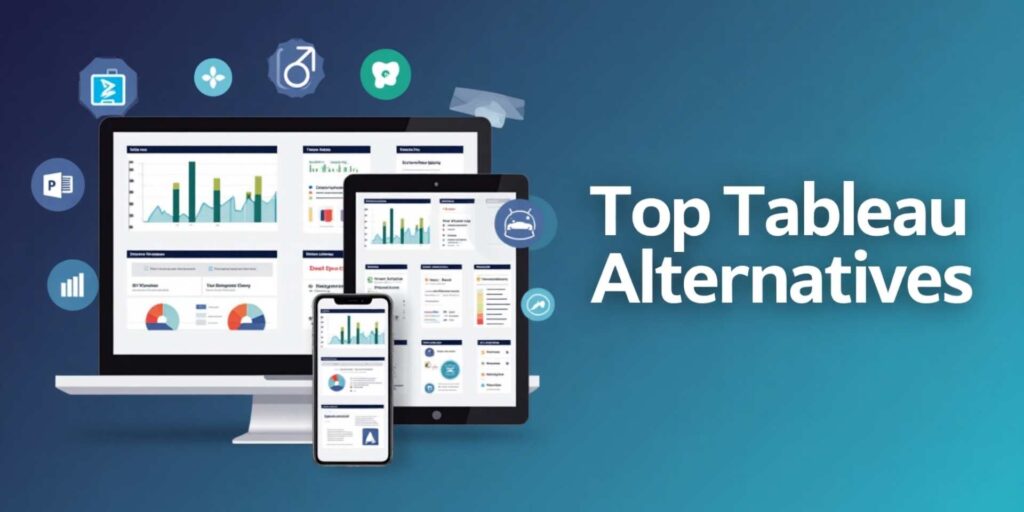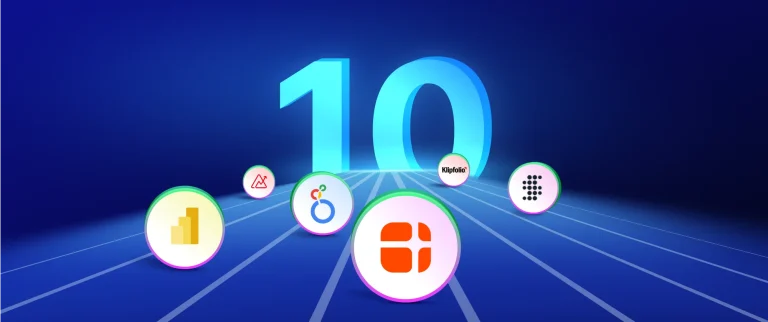The Best Alternatives to Tableau Software in 2025
Tableau has long been a leader in data visualization, but it’s not the only powerful tool available. Exploring alternatives to Tableau software can help you find a platform that better fits your budget, features, and specific business intelligence needs. This guide will walk you through top contenders, helping you make an informed choice.
Key Takeaways
- Cost is a major driver: Many businesses seek alternatives to Tableau software due to its high licensing costs, especially when scaling up.
- Functionality varies: While Tableau is strong in visualization, other tools may offer better data modeling, embedded analytics, or self-service capabilities for non-technical users.
- Open-source options provide flexibility: Tools like Apache Superset offer a high degree of customization and are free, but they require more technical expertise to set up and maintain.
- Consider your team’s skills: The best tool for your organization depends on the technical proficiency of your users. Some platforms are designed for data analysts, while others are built for business users with minimal training.
Why Look for Alternatives to Tableau Software?
Tableau is a fantastic business intelligence tool, renowned for its powerful and beautiful data visualizations. It allows users to connect to various data sources, create interactive dashboards, and share insights across an organization. However, no single tool is perfect for everyone. Many companies find themselves searching for alternatives to Tableau software for several key reasons. The most common driver is cost. Tableau’s pricing structure can become quite expensive, particularly for large teams or entire enterprises, making it a significant budget item that may not be sustainable.
Beyond the price tag, some users find Tableau’s learning curve to be steeper than they would like, especially for advanced calculations and data preparation. While it excels at visualization, its data modeling capabilities are sometimes seen as less robust compared to other platforms. Furthermore, specific needs like embedded analytics or a desire for more customizable, open-source solutions can lead teams to explore what else is on the market. The goal isn’t necessarily to find a “better” tool, but one that is a better fit for your specific workflow, budget, and technical resources.
Microsoft Power BI: The All-in-One Contender
When people discuss alternatives to Tableau software, Microsoft Power BI is often the first name that comes up, and for good reason. As part of the Microsoft ecosystem, it integrates seamlessly with other products like Excel, Azure, and Microsoft 365, which is a massive advantage for companies already invested in those tools. Power BI is known for its user-friendly interface, which feels familiar to anyone who has worked with Excel, lowering the barrier to entry for many business users. This focus on self-service analytics empowers teams to build their own reports without heavily relying on IT.
Power BI’s pricing is another huge draw. With a free desktop version for individual users and a competitively priced Pro license for sharing and collaboration, it is one of the most cost-effective BI solutions available. It is particularly strong in data modeling and preparation with its built-in Power Query engine. While some purists argue that Tableau’s visualizations are more polished, Power BI’s capabilities are more than sufficient for most business needs and are constantly improving. Its robust community and frequent updates from Microsoft make it a reliable and future-proof choice.
Google Looker Studio: Simplicity and Integration
Formerly known as Google Data Studio, Looker Studio has become a popular choice for those needing simple, effective, and free data visualization. It’s an excellent entry point into business intelligence and a strong option for small businesses, marketers, and teams deeply integrated with the Google ecosystem. Its biggest strength is its native connectivity to other Google products, such as Google Analytics, Google Ads, BigQuery, and Google Sheets. You can create a dashboard pulling data from these sources in just a few minutes.
Looker Studio emphasizes ease of use and collaboration. Its web-based interface is intuitive, allowing users to drag and drop elements to build reports. Sharing is as simple as sharing a Google Doc, with similar permission controls. While it may not have the deep analytical power or complex data modeling features of Tableau or Power BI, it excels at creating clear, shareable, and easy-to-understand dashboards. For teams whose primary need is to report on marketing performance or website metrics without a hefty price tag, Looker Studio is an unbeatable option.
Qlik Sense: The Associative Engine Powerhouse
Qlik Sense stands out in the crowded BI market with its unique Associative Engine. While most tools use a query-based model where you ask specific questions, Qlik’s engine allows you to explore data more freely. When you make a selection, it instantly highlights all related and unrelated data points across your entire dataset. This helps uncover hidden insights and relationships you might not have thought to look for. This approach to data exploration makes Qlik Sense a powerful tool for users who want to go beyond pre-built dashboards and perform true data discovery.
This platform is designed to cater to a wide range of users, from guided analytics for casual business users to advanced data preparation for analysts. It also has strong capabilities for embedded analytics, allowing you to integrate Qlik visualizations directly into your other business applications. While its pricing can be on the higher end, similar to Tableau, its unique associative technology and governance features make it a compelling choice for large enterprises that need to manage data securely while empowering users to explore it from every angle.
Sisense: For Complex Data and Embedded Analytics
Sisense has carved out a niche for itself by focusing on simplifying the handling of large, complex datasets and excelling at embedded analytics. Its proprietary ElastiCube technology (now part of its live and cached data engine) allows it to ingest and process massive amounts of data from disparate sources with incredible speed, without requiring extensive data warehousing preparation. This makes it a great choice for companies that need to merge data from many different systems—like CRMs, ERPs, and marketing platforms—into a single, unified view.
Where Sisense truly shines is in its API-first design, making it a go-to choice for companies wanting to embed analytics directly into their own products. This allows them to offer white-labeled dashboards and reports to their customers, creating new revenue streams and enhancing user experience. For organizations that see data as a product to be delivered to clients, Sisense offers a level of customization and integration that is hard to match. It provides the tools to not just analyze data, but to deliver it as a seamless part of a user-facing application.
Open-Source Alternatives to Tableau Software
For organizations with strong technical teams and a desire for ultimate customization without licensing fees, open-source BI tools are excellent alternatives to Tableau software. These platforms provide the core functionality for data connection, visualization, and dashboarding, but give you the freedom to modify the code, build custom features, and integrate them deeply into your existing tech stack. This path offers unparalleled flexibility, but it comes with the tradeoff of requiring more in-house expertise for setup, maintenance, and support.
Apache Superset
Initially developed at Airbnb, Apache Superset is now a leading open-source data exploration and visualization platform. It’s known for being fast, lightweight, and highly scalable.
- Connects to most SQL-speaking databases.
- Offers a wide array of visualization types.
- Features a no-code visualization builder and an advanced SQL editor.
- Cloud-native architecture designed for scale.
Metabase
Metabase is another popular open-source option praised for its simplicity and user-friendly interface. It’s designed to make it easy for anyone in a company, regardless of technical skill, to ask questions about data. It provides a simple question-builder for non-analysts and a powerful SQL editor for advanced users. Its focus is on getting answers quickly and easily, making it a great choice for companies wanting to foster a data-driven culture without a steep learning curve.
Zoho Analytics: For the Zoho Ecosystem User
If your business already relies heavily on the Zoho suite of products (Zoho CRM, Zoho Books, etc.), then Zoho Analytics is a natural and powerful choice. Its key advantage is its deep, seamless integration with over 500 business applications, including its own. This allows you to pull data from all corners of your business operations into one place for a holistic view. The platform has evolved significantly and now includes an AI-powered assistant, Zia, which can answer questions asked in natural language and automatically generate relevant reports.
Zoho Analytics is built to be a full-stack BI platform, covering everything from data preparation and modeling to visualization and augmented analytics. It strikes a good balance between ease of use for business users and advanced features for data analysts. Its pricing is competitive, and the value it provides, especially for existing Zoho customers, is substantial. For a deeper dive into how different tools can be leveraged for business growth, one might explore resources like those found on https://versaillesblog.com/.
Domo: The Cloud-Native BI Platform
Domo was built from the ground up as a cloud-native platform, and that architecture gives it some distinct advantages. It’s designed to connect to hundreds of data sources via pre-built connectors, making data integration a much smoother process. Domo is more than just a visualization tool; it’s a comprehensive business management platform that brings together data, people, and workflows. It places a strong emphasis on real-time data and mobile access, enabling decision-making on the go.
One of its standout features is its social collaboration tools, which are built directly into the platform. Users can comment on dashboards, tag colleagues, and have conversations around specific data points, fostering a more collaborative approach to data analysis. Domo is also highly scalable, capable of handling petabytes of data for enterprise-level clients. While it is a premium-priced product, its all-in-one nature—combining ETL (Extract, Transform, Load), data visualization, and collaboration—makes it a compelling package for businesses that want a single platform to manage their entire data pipeline.
ThoughtSpot: Search-Driven Analytics
ThoughtSpot takes a fundamentally different approach to business intelligence. Instead of having users build dashboards, it empowers them to get insights by simply searching their data, much like using Google. Users can type questions in a search bar, and ThoughtSpot’s AI-driven engine, SpotIQ, automatically analyzes the data to provide answers in the form of charts and visualizations. This “search-first” methodology dramatically lowers the technical barrier to data analysis, making it accessible to virtually anyone in an organization.
This platform is ideal for companies that want to empower their business users to conduct self-service analytics without extensive training or reliance on a dedicated data team. It’s built to handle large, complex enterprise datasets and delivers answers with impressive speed. While it still offers the ability to build traditional dashboards (called Pinboards), its core value lies in its ad-hoc query capabilities. For organizations aiming to create a truly data-literate culture where anyone can explore data and find their own answers, ThoughtSpot is a revolutionary tool.

Comparison of Leading Tableau Alternatives
|
Tool |
Best For |
Pricing (Starting) |
Key Strength |
|---|---|---|---|
|
Microsoft Power BI |
Microsoft ecosystem users, self-service BI |
Free / ~$10/user/month |
Cost-effectiveness & Excel integration |
|
Google Looker Studio |
Google ecosystem users, marketers |
Free |
Simplicity and Google product connectivity |
|
Qlik Sense |
Deep data exploration, enterprises |
Custom Quote |
Associative Engine for uncovering insights |
|
Sisense |
Embedded analytics, complex data |
Custom Quote |
API-first design for embedding dashboards |
|
Apache Superset |
Teams needing customization, developers |
Free (Open-Source) |
Flexibility and scalability |
|
ThoughtSpot |
Empowering non-technical users |
Custom Quote |
Search-driven analytics |
Conclusion
Choosing the right business intelligence tool is a critical decision that can shape how your organization uses data. While Tableau is an industry benchmark, the market is filled with powerful alternatives to Tableau software that may be a better fit for your team’s skills, budget, and specific goals. Platforms like Microsoft Power BI offer incredible value and deep integration, while tools like Qlik Sense and ThoughtSpot provide unique ways to explore data. For those needing ultimate flexibility, open-source options like Apache Superset are waiting. By evaluating your needs against the strengths of these alternatives, you can find the perfect platform to unlock the power of your data and drive smarter business decisions.
Frequently Asked Questions (FAQ)
1. What is the most popular alternative to Tableau?
Microsoft Power BI is widely considered the most popular and direct competitor to Tableau. Its combination of a low price point, ease of use for Excel users, and deep integration with the Microsoft ecosystem makes it an attractive choice for many businesses.
2. Is there a free alternative to Tableau?
Yes, there are several. Google Looker Studio is a completely free and powerful tool, especially for those using other Google services. Microsoft Power BI offers a robust free desktop version for individual use. For those with technical resources, open-source tools like Apache Superset and Metabase are also free to use.
3. Why is Power BI cheaper than Tableau?
Power BI’s pricing is part of Microsoft’s broader strategy to build an interconnected ecosystem of business tools. By making Power BI highly affordable, Microsoft encourages adoption, which in turn drives the use of its other paid services like Azure and Microsoft 365. This scale allows them to offer it at a lower price than standalone vendors like Tableau.
4. Which BI tool is best for beginners?
Google Looker Studio and Metabase are often cited as the easiest tools for absolute beginners due to their intuitive, web-based interfaces and simple setup. Microsoft Power BI is also very beginner-friendly, particularly for anyone with experience using Microsoft Excel.
5. Can these alternatives handle large datasets like Tableau can?
Yes, most enterprise-grade alternatives like Power BI, Qlik Sense, Sisense, and Domo are designed to handle very large datasets. Open-source tools like Apache Superset are also built for scale. The performance often depends more on the underlying database and the architecture of the BI implementation than the tool itself.
6. Do I need to be a data scientist to use these tools?
No. While data scientists can certainly leverage these tools for complex analysis, most modern BI platforms are designed with “self-service” in mind. They include user-friendly interfaces, drag-and-drop report builders, and even AI assistants to empower business users with little to no technical background to create their own reports and find insights.














Post Comment